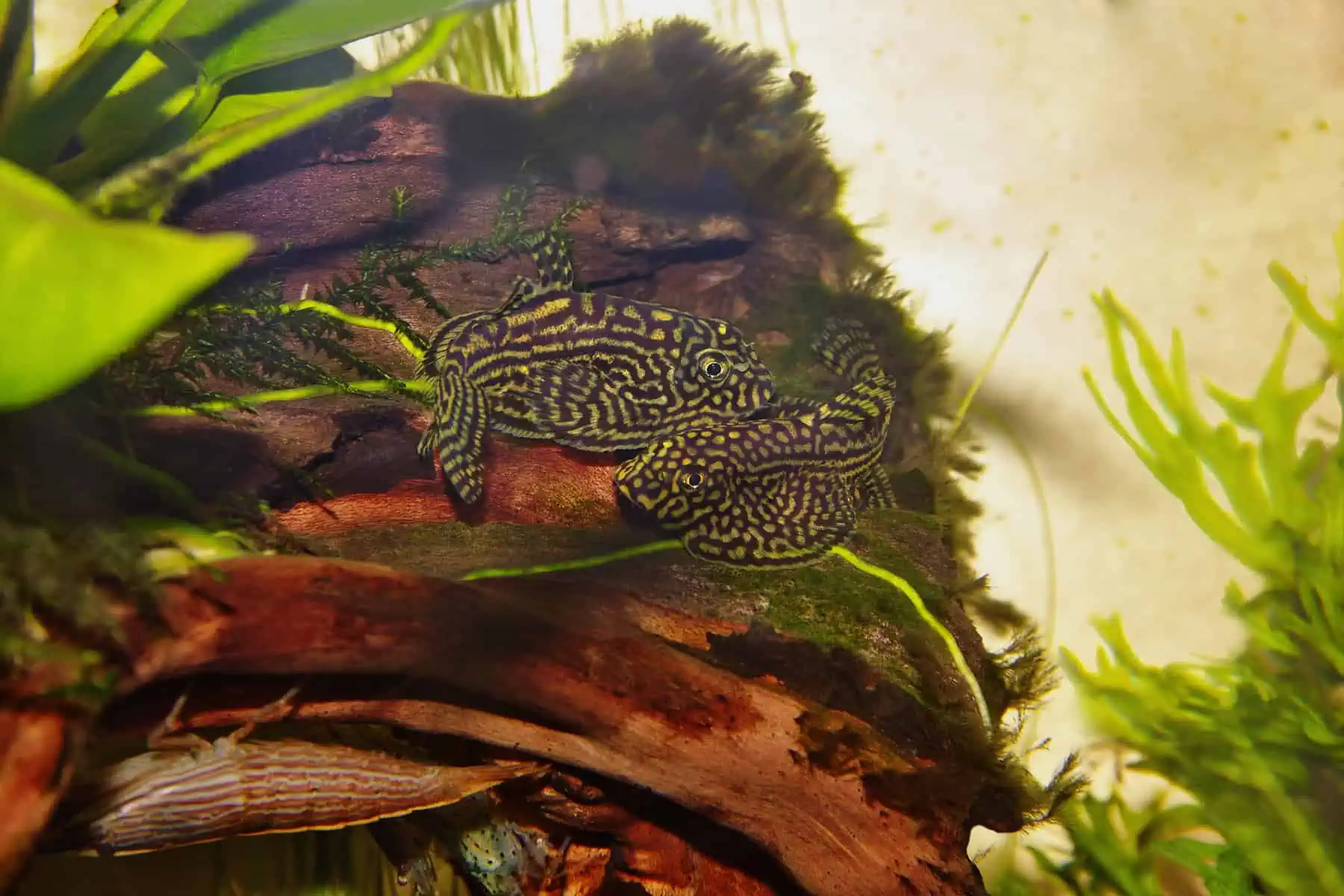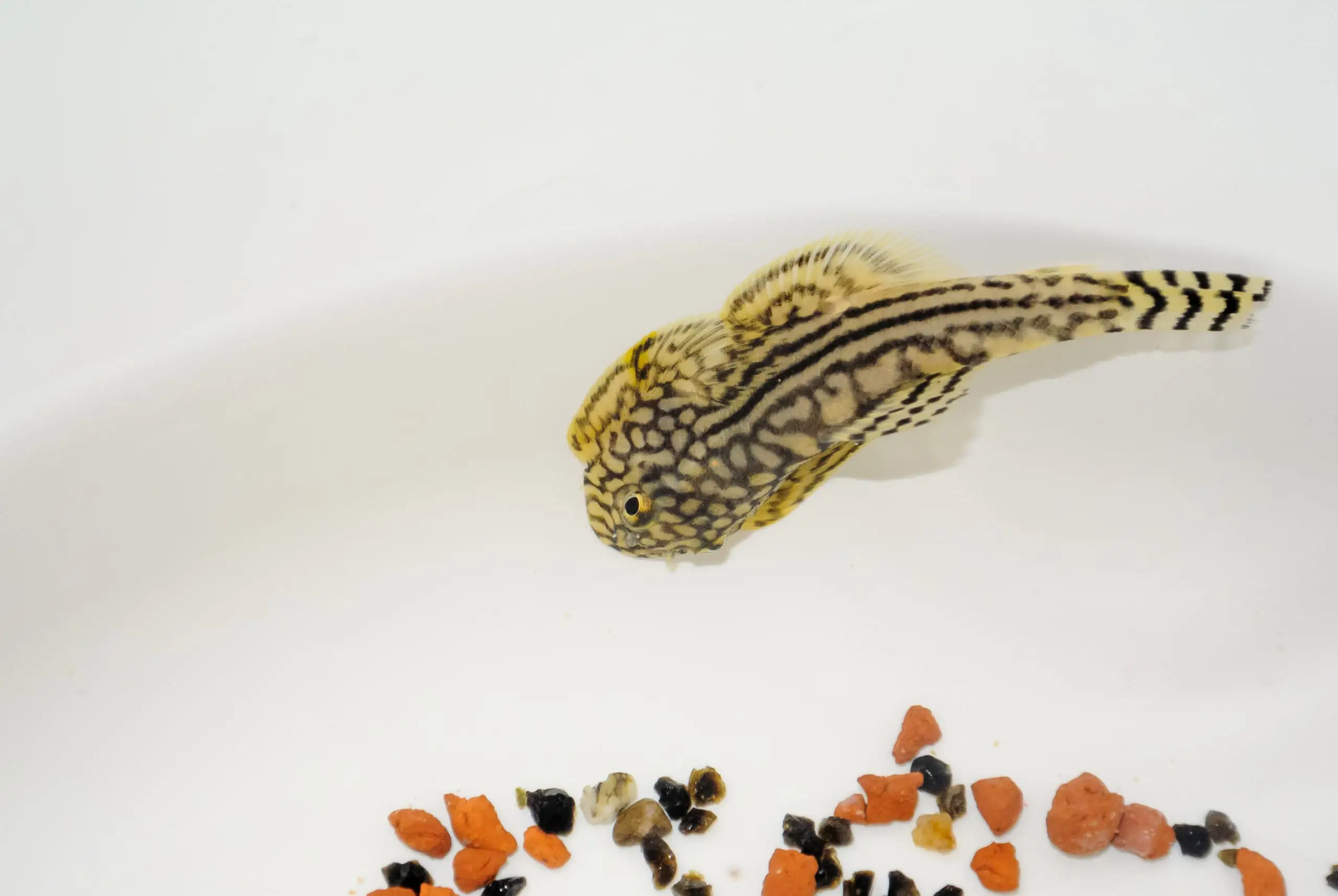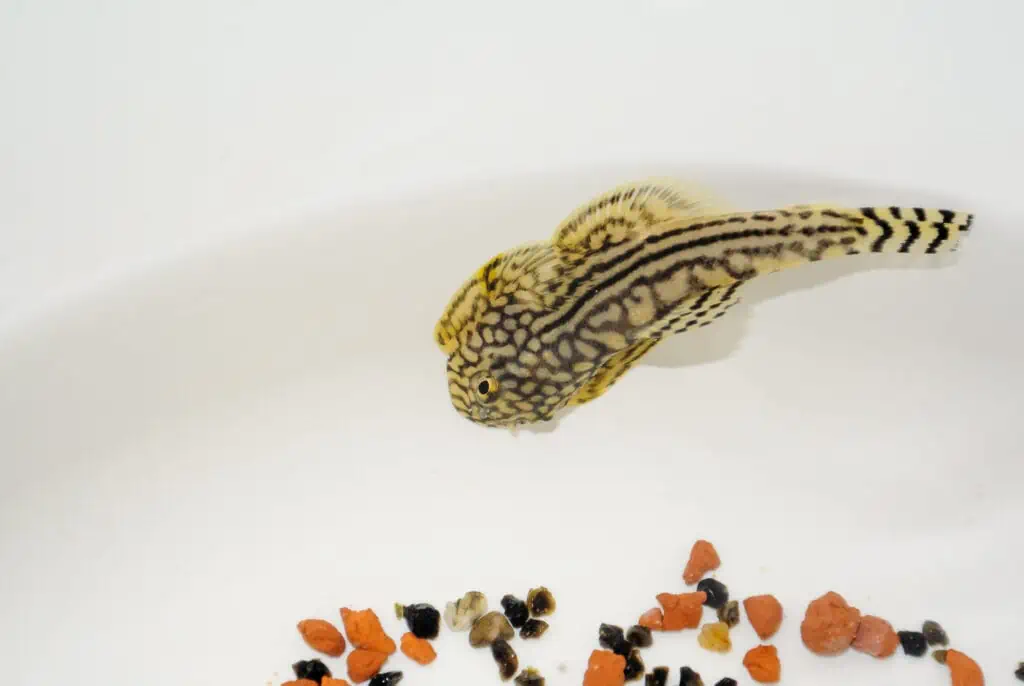There are many different types of Hillstream loaches belonging to a family of bottom-dwelling fish that hails from the clear, rapidly-flowing waters of Asia.
The Reticulated Hillstream loach is a beautiful, unusual-looking fish that makes an eye-catching addition to any freshwater community setup. These fish are hardy and pretty straightforward to care for, too, making them a good choice for those who are new to the hobby.
Read this guide to learn everything you need to know about keeping these gorgeous little loaches.
Reticulated Hillstream Loach – At a Glance
| Hillstream Loach Info | |
|---|---|
| Scientific Name: | Sewellia Lineolata |
| Common Name (species) | Reticulated Hillstream loach |
| Family | Balitoridae, Cypriniformes order |
| Origin | Southeast Asia, China, India |
| Diet | Omnivorous |
| Care Level | Beginner |
| Activity | Active scavengers |
| Lifespan | 8 to 10 years |
| Temperament | Peaceful community fish |
| Tank Level | Bottom-dweller |
| Minimum Tank Size | 50 gallons |
| Temperature Range | 68° to 72° F |
| Water Hardness | 10 - 15 dKH |
| pH Range | 6.5 to 7.5 |
| Filtration/Flow Rate | Needs a strong flow rate and pristine, well-oxygenated water |
| Water type | Freshwater |
| Breeding | Egg layer |
| Compatibility | Can live with other non-aggressive community fish |
| OK, for Planted Tanks? | Yes |
Origins
There are 202 species of Hillstream loaches that can be found in southeast Asia, China, and parts of India, although their numbers are decreasing, primarily due to habitat loss.
Natural Habitat
Reticulated Hillstream loaches inhabit fast-flowing streams, foraging on the substrate or clinging to rocks in the current. Although not generally regarded as schooling fish, these loaches are typically found in small groups.
The majority of the loaches’ natural diet comprises algae, which is supplemented with small worms, insect larvae, and the like.
Appearance
The Reticulated Hillstream loach is a beautiful, unique-looking fish that’s bound to create a talking point in any home aquarium setup!
These fish resemble mini stingrays and have short barbels, which means they’re sometimes wrongly assumed to be a species of catfish. The fish has a light yellow-gray body with random, wide black stripes that create a striking dappled pattern, including on the fins.
Reticulated Hillstream loaches are ideally adapted for their environment. The fish is streamlined and hydrodynamic, meaning it can live in fast-flowing water without much effort. The pectoral and pelvic fins are fanlike, and the fish uses them to move around and grab onto rocks so that it doesn’t get swept away in the current.
In addition, the loaches’ flat underbelly and sucker mouth are perfect for withstanding the water’s force and grazing on algae.
Size
Reticulated Hillstream loaches measure around 2 to 3 inches in length, so they can easily forage for food in tiny cracks and crevices in their rocky home. In the aquarium, the fish often fix themselves to your viewing panes or decorative rocks in groups, giving you a perfect view.
Lifespan
Tank-kept Reticulated Hillstream loaches typically survive for 8 to 10 years, provided that they receive a high-quality diet and are kept in optimum conditions.
Activity Level/Temperament
Although these fish are very active and love to spend their days foraging around the tank, grazing on algae, or exploring rocky crevices and around plant bases, they are peaceful and excellent for community tanks.
Compatibility and Tankmates
As previously mentioned, you can safely keep Hillstream loaches in a community tank with other non-aggressive species.
These fish can live happily in groups, but be careful not to overstock your tank or scuffles can break out between bottom-dwelling fish.
Tank Mates
Hillstream loaches prefer cooler temperatures than many tropical community species, so don’t choose fish that need very warm conditions. In addition, these fish need a very fast flow rate, which doesn’t suit many species, so you will need to choose tank mates for them very carefully.
Fish species that can work well with Hillstream loaches include Chili rasboras, White Cloud Mountain Minnows, and Celestial Pearl danios, and you can also keep shrimp and snails safely with them.
Fish To Avoid
It’s best to avoid keeping large, territorial fish species such as Oscars, Angelfish, and cichlids that can be nippy and could harass the loaches, potentially leading to outbreaks of disease.
What To Feed Reticulated Hillstream Loaches
Hillstream loaches are omnivores that graze on algae and biofilm on the tank surfaces. However, you also need to include some meaty protein in their diet, such as bloodworms, brine shrimp, insect larvae, and daphnia.
Tropical fish flakes, algae wafers, and mini pellets are also useful additions to the fish’s diet.
What About Live Foods?
Although your loaches will enjoy some live food in their diet, it can sometimes come with bacteria and parasites that can attack your fish. So, unless you have a reliable supplier, I recommend offering your loaches frozen and freeze-dried foods instead.
How Much and How Often To Feed Hillstream Loaches

Be careful not to overfeed your loaches, as that can cause digestive problems, and any leftover food will decompose and contaminate your tank.
I recommend feeding your fish twice a day, giving them only what they will clear in a few minutes.
Tank Requirements
If you want to keep a small group of Hillstream loaches, you will need a large tank of at least 50 gallons.
I recommend choosing a long, rectangular tank rather than a tall one because that provides the fish with plenty of space at the bottom of the tank where they live. In addition, a long tank provides a greater surface area for the maximum gaseous exchange to supply these oxygen-hungry fish.
Aquarium Setup
As with all captive fish, replicating their natural environment as closely as possible in the tank is the key to creating a healthy, enriched environment for your pets.
Substrate
I recommend using a soft, sandy substrate since Reticulated Hillstream loaches spend most of their lives foraging in the substrate. If you use a coarse gravel substrate, it’s possible that your fish will be injured.
Decoration
Hillstream loaches like a well-planted aquarium that includes plenty of hiding places and foraging areas. Sturdy plants to use include Anubias barteri and Java moss, and your loaches will love rooting around between the plant bases.
To accommodate the loaches’ habit of grazing on algae and biofilm on tank surfaces, be sure to include plenty of rockwork, smooth stones, and driftwood in your setup.
Habitat Requirements
It’s always best to introduce Hillstream loaches to a well-established, mature tank rather than a brand-new setup.
Filtration
Hillstream loaches need a pristine environment, so you’ll need a highly efficient filtration system to keep the water crystal clear and well-oxygenated.
I recommend using powerheads together with an external canister filter that will provide the fish with the high flow rate they need, as well as keeping the tank well-oxygenated.
Water Parameters
Hillstream loaches need a water temperature of between 68° and 72° F. Note that if the water in the tank is consistently over 72° F, your loaches won’t thrive and might even die.
The water in your tank should be slightly acidic, with a pH level of 6.5 to 7.5 and a water hardness of between 10 and 15 dKH.
Lighting
Reticulated Hillstream loaches don’t have any specific lighting requirements, so you can go with a regular LED aquarium lighting unit that suits your chosen plant species.
Tank Maintenance
A pristine tank is essential for healthy Hillstream loaches, and these fish need extremely well-oxygenated water to do well.
As part of your regular maintenance routine, you’ll need to carry out 30% weekly water changes and use an aquarium vacuum to remove organic waste from deep within the substrate and around the tank bottom.
Rinse the filter media in tank water to get rid of clogging and sludge to ensure an unobstructed flow of water through the filtration unit, and remember to change the filter media regularly, as recommended by the manufacturer.
Water Testing
I recommend you test the water every week using an aquarium water testing kit to be sure that ammonia and nitrite levels are zero and nitrates are around 20ppm or less. It’s also a good idea to check the water hardness and pH levels to make sure they’re still within the loaches’ acceptable parameters.
Health and Disease

Reticulated Hillstream loaches are quite hardy creatures, although they can suffer from some of the fish diseases that commonly affect tank-kept tropical fish.
These are active fish that enjoy spending time in a group and foraging for algae with their companions.
Red Flags
If you notice your fish showing any of the following behaviors, that could be a sign of impending health problems:
- Not eating or grazing on tank surfaces
- Not swimming with their conspecifics and other tank mates
- Lack of activity
- Patches of reddened skin, bleeding ulcers and sores, torn fins
- Flicking or flashing against solid objects in the aquarium or rubbing on the substrate
Breeding
Unfortunately, breeding these fish in your home tank is extremely difficult, and the Hillstream loaches that are sold online and in fish stores are typically raised by professional, commercial fish breeders in Asia and Eastern Europe.
However, there’s no reason why you can’t try a breeding project if you have the time to devote to it.
Gender Determination
Telling the difference between male and female Reticulated Hillstream loaches is relatively straightforward, although if you keep a small group of fish, it’s a fairly safe bet that you’ll end up with a mixture of both sexes.
Wait until the fish are stuck to the aquarium glass, and then observe them from underneath and above. Male Reticulated Hillstream loaches have a more prominent head than females and are slightly longer.
Spawning
When the fish are ready to spawn, the male courts the female by “dancing” for her. If the female is impressed, she’ll stick close by, showing him that she’s interested.
It’s the male that constructs a nest in the substrate, where the female deposits her eggs once she’s happy with the male’s work. Once the eggs are laid, the male fertilizes them, and the fry typically hatches within a couple of weeks.
Adult Hillstream loaches are very good parents, and, unlike many other tropical fish species, they don’t eat their eggs and fry, so you can safely leave the family together without needing to move them to a separate tank setup.
Availability
Hillstream loaches are quite widely available from good fish stores and from online dealers and auctions for around $12 each.
Final Thoughts
Did you enjoy our guide to keeping the unusual and beautiful Reticulated Hillstream loach? If you did, please remember to hit the share button before you go.
Hillstream loaches are unusual, beautiful aquarium fish that can make a fabulous addition to a community tank. These active, bottom-dwelling, peaceful fish spend much of their day foraging for food scraps around plant bases or grazing on algae, helping to keep the tank clean and tidy.
You’ll need to keep these fish in small groups in a large, well-maintained aquarium with excellent oxygenation and a strong current.


